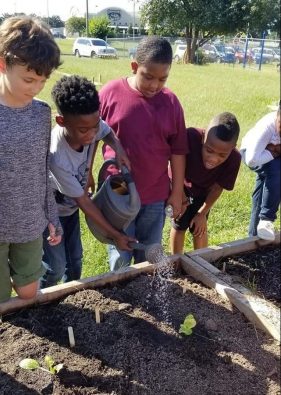Private: April Showers Bring May Veggies
School gardens are a fantastic way to transition a more traditional classroom to an outdoor, experiential learning opportunity centered on student engagement and critical thinking.
Read More School gardens are a fantastic way to transition from a more traditional classroom to an outdoor, experiential learning opportunity centered on student engagement and critical thinking. Students are able to physically connect with nutrition education, understand the process of growing healthy foods, and recognize environmental stewardship. A school garden can also be integrated into many subjects such as math, science, health, literacy and social studies.
School gardens are a fantastic way to transition from a more traditional classroom to an outdoor, experiential learning opportunity centered on student engagement and critical thinking. Students are able to physically connect with nutrition education, understand the process of growing healthy foods, and recognize environmental stewardship. A school garden can also be integrated into many subjects such as math, science, health, literacy and social studies.
A school garden takes some planning, but the effort is worth the reward. Here are some steps to start a school garden:
A school garden is also a great way to engage your school’s parents and families to be actively involved in your wellness initiatives.
Self-Awareness: Harvesting fruits and veggies that children have worked so hard to grow is the perfect opportunity for students to celebrate the success of their own hard work. A school garden provides chances for children to be a part of something bigger than themselves and gain self-confidence and self-efficacy by recognizing their capacity to use their skills to achieve their goals. Students will develop a sense of ownership for their health when they experience growing their own food from seed to yum!
Responsible Decision Making: Growing veggies requires patience, evaluation, and reflection. Students can work together to problem solve and analyze solutions to assure that all of the plants in the garden reach their fullest potential. Gardens provide ample opportunities to teach children about responsibilities in care-taking and problem solving.
Involve as many students as possible in harvesting to experience the growing process from beginning to end. This can be challenging if crops are harvested in the summer – Consider planning a harvest celebration around back-to-school time or planting a fall or spring garden (when produce is ready to harvest during the school year).
Use your harvest to have a taste test!
Incorporate science concepts of plant biology or writing skills by having students write about the garden and the importance of good nutrition.
Strive to ensure that students are engaging with the garden at least twice per month, either through being out in the garden or garden-based lesson plans.
Utilize volunteers! Host a weekend volunteer event to help you get started. Invite school and community members to help construct planter beds, fill pots with soil and plant seeds. Have volunteers assist with garden maintenance during the summer – weeding, watering and trimming.
Determine early on if you plan to transplant spouts outside. Container gardens are great for getting plants started indoor, especially during the off season. About 2 weeks before transplanting the seedlings outdoors, move them outside for increasingly longer periods each day. Prepare the garden with plenty of compost and soil, and transplant the seedlings to the garden on a cloudy day or late afternoon. Water appropriately and enjoy!
Plant with love. While planting, encourage students to be more aware of the present moment and their surroundings. Encourage them to connect with the earth and the practice of gardening as a way to feel calm and in tune with their feelings. Discuss the process of going from a seedling to a fresh cucumber or juicy tomato and all the steps that took place during that journey.
Students with disabilities can participate in the school garden project in some way, since there are many different types of tasks and various ways to adapt to accomplish them. They may need extra direction to follow the plan or accommodations for lifting lesser amounts of weight or digging with trowels rather than shovels, filling buckets rather than carrying them. They can help with placing strings for boundaries and rows of plants; fill pots with soil, pull weeds with direction. They may work with other students or adult leaders who can help them focus and follow directions as needed. Students who have disabilities that involve following directions, self-management, or personal behavior anomalies must be supervised when using equipment or materials with safety risks.
Whether your garden is growing alongside the playground or a classroom windowsill, gardening is a great place to practice mindfulness and encourage creative thinking. Invite children to use their senses to experience the different textures, smells and sounds. Remind children that gardening can sometimes be tough and getting the balance just right can take time. Help them experience the whole process and celebrate the small achievements along the way.
Be mindful of the plants needs! Just like us, not enough or too much water can make as feel a little off. Small containers can be overwatered and can dry out over long breaks or weekends. Similarly, if the plants are receiving too much or too little sunshine, they may not thrive.
For more activities and ideas like this one, be sure to sign up for our news and updates. And if you like what you see, please donate to support our work creating more ways to help build a healthier future for kids.
Categories: Nutrition & Healthy Eating, At School, Digital Resource